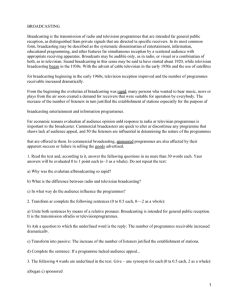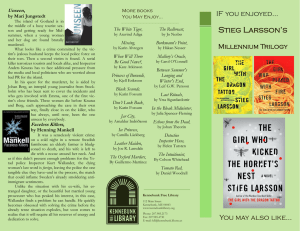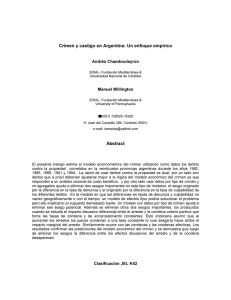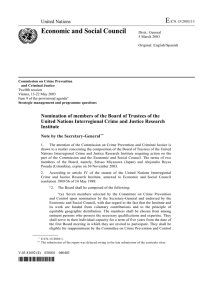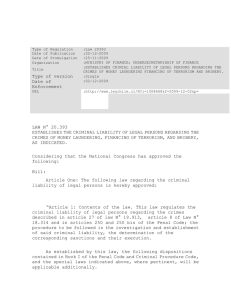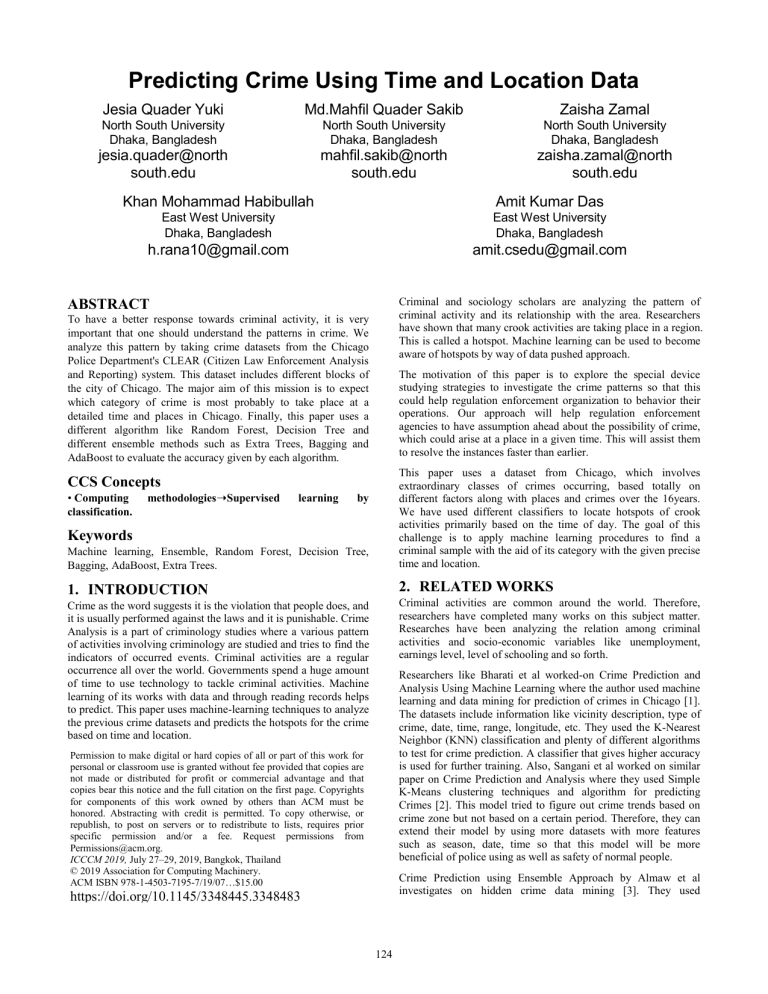
Predicting Crime Using Time and Location Data Jesia Quader Yuki Md.Mahfil Quader Sakib Zaisha Zamal North South University Dhaka, Bangladesh North South University Dhaka, Bangladesh North South University Dhaka, Bangladesh jesia.quader@north south.edu mahfil.sakib@north south.edu zaisha.zamal@north south.edu Khan Mohammad Habibullah Amit Kumar Das East West University Dhaka, Bangladesh East West University Dhaka, Bangladesh [email protected] [email protected] Criminal and sociology scholars are analyzing the pattern of criminal activity and its relationship with the area. Researchers have shown that many crook activities are taking place in a region. This is called a hotspot. Machine learning can be used to become aware of hotspots by way of data pushed approach. ABSTRACT To have a better response towards criminal activity, it is very important that one should understand the patterns in crime. We analyze this pattern by taking crime datasets from the Chicago Police Department's CLEAR (Citizen Law Enforcement Analysis and Reporting) system. This dataset includes different blocks of the city of Chicago. The major aim of this mission is to expect which category of crime is most probably to take place at a detailed time and places in Chicago. Finally, this paper uses a different algorithm like Random Forest, Decision Tree and different ensemble methods such as Extra Trees, Bagging and AdaBoost to evaluate the accuracy given by each algorithm. The motivation of this paper is to explore the special device studying strategies to investigate the crime patterns so that this could help regulation enforcement organization to behavior their operations. Our approach will help regulation enforcement agencies to have assumption ahead about the possibility of crime, which could arise at a place in a given time. This will assist them to resolve the instances faster than earlier. Machine learning, Ensemble, Random Forest, Decision Tree, Bagging, AdaBoost, Extra Trees. This paper uses a dataset from Chicago, which involves extraordinary classes of crimes occurring, based totally on different factors along with places and crimes over the 16years. We have used different classifiers to locate hotspots of crook activities primarily based on the time of day. The goal of this challenge is to apply machine learning procedures to find a criminal sample with the aid of its category with the given precise time and location. 1. INTRODUCTION 2. RELATED WORKS Crime as the word suggests it is the violation that people does, and it is usually performed against the laws and it is punishable. Crime Analysis is a part of criminology studies where a various pattern of activities involving criminology are studied and tries to find the indicators of occurred events. Criminal activities are a regular occurrence all over the world. Governments spend a huge amount of time to use technology to tackle criminal activities. Machine learning of its works with data and through reading records helps to predict. This paper uses machine-learning techniques to analyze the previous crime datasets and predicts the hotspots for the crime based on time and location. Criminal activities are common around the world. Therefore, researchers have completed many works on this subject matter. Researches have been analyzing the relation among criminal activities and socio-economic variables like unemployment, earnings level, level of schooling and so forth. CCS Concepts • Computing classification. methodologies➝Supervised learning by Keywords Researchers like Bharati et al worked-on Crime Prediction and Analysis Using Machine Learning where the author used machine learning and data mining for prediction of crimes in Chicago [1]. The datasets include information like vicinity description, type of crime, date, time, range, longitude, etc. They used the K-Nearest Neighbor (KNN) classification and plenty of different algorithms to test for crime prediction. A classifier that gives higher accuracy is used for further training. Also, Sangani et al worked on similar paper on Crime Prediction and Analysis where they used Simple K-Means clustering techniques and algorithm for predicting Crimes [2]. This model tried to figure out crime trends based on crime zone but not based on a certain period. Therefore, they can extend their model by using more datasets with more features such as season, date, time so that this model will be more beneficial of police using as well as safety of normal people. Permission to make digital or hard copies of all or part of this work for personal or classroom use is granted without fee provided that copies are not made or distributed for profit or commercial advantage and that copies bear this notice and the full citation on the first page. Copyrights for components of this work owned by others than ACM must be honored. Abstracting with credit is permitted. To copy otherwise, or republish, to post on servers or to redistribute to lists, requires prior specific permission and/or a fee. Request permissions from [email protected]. ICCCM 2019, July 27–29, 2019, Bangkok, Thailand © 2019 Association for Computing Machinery. ACM ISBN 978-1-4503-7195-7/19/07…$15.00 Crime Prediction using Ensemble Approach by Almaw et al investigates on hidden crime data mining [3]. They used https://doi.org/10.1145/3348445.3348483 124 records 1995 FBI Uniform Crime Reporting (UCR), Iqbal et al. found an accuracy of 83.95% when used Decision Tree and Naive Bayesian set of rules is used to predict the category of crimes for various states of the USA [12]. Similarly, Dash et al. analyze Chicago city crime facts fused with different social information sources the usage of community analytic strategies to expect a criminal activity for the following 12 months [13]. They experimented with polynomial, auto-regressive and support vector regression methods and determined that the first-rate of support vector regression considerably outperforms other methods. ensembled classification learning methods. They used Naïve Bayes classification and artificial network to test for crime analysis. They identify the crime trends and patterns and predicts the type of crimes might occur next in a specific locality of longitude and latitude in a specific schedule of time and season. Therefore, they can further implement the required combined techniques for improving a better crime prediction of a single classifier model by integrating multiple models by using more datasets with more features. Some researchers like Tabedzki et al. used the random forest model. By the usage of random forest and k-nearest neighbor, researchers obtained the first-rate accuracy across 39 different categories [4]. Since the information was very noisy, consequently they thought random forest might provide great effects. Sathyadevan et al endorse an approach for detecting and figuring out crime using data mining and machine learning techniques [14]. They implemented k-means clustering for crime detection, where it generates two crime-clusters. To increase k-means achieved results, they added GMAPI, which embeds Google maps through NetBeans. The accuracy that they receive from their model is of 93.62% and 93.99%, respectively. Paper on Different Approaches for Crime Prediction system by Varshitha D N et al. predicted crimes based on location and time from previous crimes data records [15]. They applied deep learning technique to predict crimes and analyzed sentimental techniques too. Ingilevich et al used criminal datasets of the city of Saint-Petersburg to implant the type of the crimes and tried to predict the possible crimes in future on specific urban area depending on time to decrease the crimes of that area [16]. They used logistic regression, linear regression, gradient boosting for this predicting forecasting classification model. In addition, they compared with the predictive results and figured out that gradient boosting gives the high accuracy for this model. They can further extend their work by focusing on longitude and latitude of a specific urban area with more features. Sadhana and Sangareddy have used twitter records and sentiment evaluation to predict crime in real time [17]. They extensively utilized this fact to map the awareness of crime occurrences and discover huge scale hotspots. 90%. This paper aims to predict the crime occurrences in Chicago based on time and location. The algorithms are trained with time attributes such as “Day”, “Month”, “Year”, “Hour”, “Minute”, “Second” and with location attributes such as “Location”, “Location Description”, “Block”, “Latitude” and “Longitude”. In addition, Phua et al. offer a new fraud detection technique that is built by thinking about existing fraud detection research [5]. Three distinctive algorithms are used at the identical skewed statistics. Using these algorithms, the accuracy obtained is greater than 90%. Chandrasekar et. al. implemented Gradient Boosted trees and Support Vector Machines in their other paper and showed that their work on implemented algorithm gives high accuracy [6]. They have worked on especially centered on one-ofa-kind cities. Last works related to crimes in different cities, expected many kinds of crimes occurring in the metropolis. The paper has discovered that the maximum suitable classifiers that possible practice on those sorts of datasets can be tree-based methods. Kang et al. analyzed crime occurrences by the usage of multimodal records in which they have applied deep learning [7]. They found out that DNN version provides greater precision values in predicting crime prevalence than other prediction fashions when they are compared with other works. Their present crime predicting methodology for finding occurrences is not able to produce statistics based on the unique form of at a selected time. Prediction of Hourly Effect of Land Used on Crime by Matijosaitiene et al predicted future crimes based on the time using Manhattan [8]. They used the random forest and logistic regression for their predicting model of crimes based on exact time features when most of the crimes happened. They achieved high accuracy on random forest algorithms. They also tried to analyze hot spot feature to predict for controlling crimes in different areas. In their future work, they can also add specific longitude and latitude of a specific area where crimes mostly committed. 3. METHODOLOGY This paper uses a specific dataset to train the algorithm. The algorithm that is used to train the dataset are Random Forest, Decision Tree and different ensemble methods such as Extra Trees, Bagging and AdaBoost. Survey of Crime Analysis and Prediction by Mookiah et al studied crime connected variables, which showed the influencing factor of crimes and tried to figure out the rate of crimes [9]. Boni et al worked-on Area-Specific Crime Prediction Models where they predicted crimes by using zip code located specific area [10]. In their model, they used crime datasets from Chicago where they tried to discover two types of model one is hierarchical models based on certain locality and another is regularized multitasking for this model. Naïve Bayes Approach for the Crime Prediction in Data Mining by Jangra et al used Machine learning techniques and regression techniques for predicting and analyzing of criminal datasets related for predicting crimes in India based on time and location [17] [18] [11]. This model gives uniform characteristics result for noisy data but KNN regression techniques and Naïve Bayes are utilized for this model and Naïve Bayes gives the high accuracy for this predictive model. The following steps are followed for all the implemented algorithms: Figure 1. Proposed system. Combining two datasets - 1990 US Law Enforcement Management and Administrative Statistics (LEMAS) and crime 125 In Fig 2. y axis on the graph shows the number of crime rates and x axis on the graph shows years over the time period from 2001 to 2017. Before the year 2008, there was a fluctuation in crime rates. In 2008, there was the highest occurrence of crime activities Later, the crime rates began to fall. 3.1. Features The dataset that is used is collected from the Chicago Police Department's CLEAR (Citizen Law Enforcement Analysis and Reporting) system. The datasets consist of facts on crime prevalence that has taken area in Chicago over the time of 1/1/2001 to 1/1/2017. The dataset that we used is in a CSV format, which contains more than 6,000,000 records/rows. There are different attributes of the dataset. The attributes that are used in this paper is given in the table: Table 1. Attributes that is used from the datasets Location Description Description FBI Code Block Location Year Latitude Figure 3. Shows criminal activities happening over a year. In Fig 3. months are in x-axis and count is in the y-axis. January to December is represented by 1 to 12. The highest occurrence of crime rate is during the month of May and the lowest occurrence of crime rate is on the month of February. Longitude Month Day Hour Minute Second Primary Type 3.2. Data Preprocessing For preprocessing the dataset, this paper used Tabular software and Python library Scikit-learn (sklearn). 1. The dataset consists of some attributes, which are string values, and other attributes are in numeric values. To train the model, the text features in this paper’s dataset needs to be converted right into a numeric value. This conversion is dealt with by means of the usage of Python library NumPy. 2. Attributes in our dataset with string type are “Date”, “Location”, “Location Description” etc. Using python, this paper assigned numeric values for those capabilities. 3. Since time is considered as the main factor thus “Date” has been split into “Day”, “Month”, “Year”, “Hour”, “Minute”, “Second” attributes. Figure 4. Criminal activities occurring in the different hour of the day. In Fig.4. y axis represents count and x axis represents hour (in 24 hours format). Most crimes occur for the duration of the afternoon evening. There is a huge change in crook activities at some point at the time of 6 PM and 8 PM. At 5 AM, the variety of crime prevalence is least. Figure 2. Shows criminal activities happening since 2001 to 2017. Figure 5. Criminal activities occurring on different days. 126 In Fig.5. Number of crime occurrences is represented in y axis and different days over a month is represented in x axis. Most crimes occur during the beginning of the month and decrease at the end of the month. Decision Tree 99.88% AdaBoost 74.78% Bagging 99.92% The dataset that we used is imbalance as 20000 (Theft) have the highest frequency for the specific crime occurrences and the lowest frequency is six for another crime occurrences (Stalking). That is why; we want to lessen the training, which has a lower frequency to end up with the balanced dataset. Extra Tree 97.10% The table 2 shows that Bagging gives the highest accuracy and AdaBoost gives the lowest accuracy among the fixed algorithm that is used. Only the top 18 crime classes are utilized to try to reduce the range of instructions out of 30 categories. All other crime lessens are categorized through “Other offenses”. Highest accuracy is acquired with the implement of Bagging because ensemble method combines several tree classifiers and gives much better predictive results. The main reason of difference in actual and predicted values are noise, variance, and bias. Bagging gives an accuracy of 99.92%, thus minimizing the maximum difference between actual and predicted values. AdaBoost creates a strong classifier from several weak classifiers. AdaBoost generally works best for binary classification. The dataset used in this paper consists of different categories of crimes. Therefore, it is a multiclass classification problem. Thus, AdaBoost provides lowest accuracy among all the algorithm used. 5. CONCLUSION This paper uses five different types of algorithms to predict the type of crime that might occur based on time and location. The algorithm involving trees showed that the predicted results is very much closer to the actual results. Thus, the dataset used, provides the maximum correct result with higher accuracy when implemented with different tree classifiers. The stated results in this paper show that Bagging method works best and AdaBoost works least well for predicting crimes using time and location. The results in this paper provides similar results when implemented with tree-based algorithms. Therefore, this paper expects to get more variation in the results when implemented with other classifying algorithms in the future. Figure 6. shows 13 classes of “Other crimes”. In Fig 6. shows specific crimes which are considered as “Other crimes. This is because the number of occurrences involving those crimes are lower, compared to other classes of crimes available in the dataset. 6. REFERENCES 4. RESULTS [1] Alkesh Bharati and Dr Sarvanaguru RA.K. 2018. Crime Prediction and Analysis Using Machine Learning. This paper uses dataset which contains both the mixture of categorical and numeric values. Thus, the paper mainly focuses on those algorithms which can work on the combination of both categorical and numeric values. Also, keeping in mind that, the algorithm performs well for our classification problem. Therefore, several algorithms are chosen to serve the purpose such as Decision Tree, Random forest and several ensemble methods such as Bagging, AdaBoost and ExtraTree Classifier. [2] Ankit Sangani, Vijaya Pinjarkar and Chirag Sampat. 2019. Crime Prediction and Analysis, 2nd International Conference on Advances in Science & Technology. [3] Ayisheshim Almaw and Kalyani Kadam. 2018. Survey Paper on Crime Prediction using Ensemble Approach, International Journal of Pure and Applied Mathematics, 118 (8), 133-139 [4] Christian Tabedzki, Amruthesh Thirumalaiswamy and Paul van Vliet. 2018. Yo Home to Bel-Air: Predicting Crime on The Streets of Philadelphia The main motive of this paper is to use algorithms on these datasets to classify the type of crime occurring based on time and location. The chosen algorithms are applied where it provides a simple and fast way of learning a function. This is where the algorithm maps data x to outputs y, where x is a mixture of categorical and numeric variables and y is the categorical value for classification. The applied algorithm gives better performance for any classification problem. [5] Clifton Phua, Damminda Alahakoon and Vincent Lee. 2004. Minority Report in Fraud Detection: Classification of Skewed Data, Sigkdd Explorations, 6(1),51-5 [6] Tayal, D.K., Jain, A., Arora, S., Agarwal, S., Gupta, T. and Tyagi, N., 2015. Crime detection and criminal identification in India using data mining techniques. AI & society, 30(1), pp.117-127. https://doi.org/10.1007/s00146-014-0539-6 The result after reducing the classes is shown in the below table for all algorithms. [7] Hyeon-Woo Kang and Hang-Bong Kang. 2018. Prediction of crime occurrence from multimodal data using deep learning. DOI= https://doi.org/10.1371/journal.pone.0176244 Table 2. Comparison of accuracy Algorithm Accuracy Random Forest 95.99% [8] Irina Matijosaitiene, Peng Zhao, Sylvain Jaume and Joseph W. Gilkey Jr. 2018. Prediction of Hourly Effect of Land Use 127 on Crime, International Journal of Geo-Information, 8, 16, https://doi.org/10.3390/ijgi8010016 [14] Sathyadevan, S. and Gangadharan, S., 2014, August. Crime analysis and prediction using data mining. In 2014 First International Conference on Networks & Soft Computing (ICNSC2014) (pp. 406-412). IEEE. [9] Mookiah, L., Eberle, W. and Siraj, A., 2015, April. Survey of crime analysis and prediction. In The Twenty-Eighth International Flairs Conference. [15] Varshitha D N, Vidyashree K P, Aishwarya P, Janya T S, K R Dhananjay Gupta and Sahana R. 2017. Paper on Different Approaches for Crime Prediction system, International Journal of Engineering Research & Technology (IJERT), 5(20) [10] Al Boni, M. and Gerber, M.S., 2016, December. Areaspecific crime prediction models. In 2016 15th IEEE International Conference on Machine Learning and Applications (ICMLA)(pp. 671-676). IEEE. https://doi.org/10.1109/ICMLA.2016.0118 [16] Varvara Ingilevich and Sergey Ivanov. 2018. Crime rate prediction in the urban environment using social factors, Procedia Computer Science, 136, 472–478 [11] Mrinalini Jangra and Shaveta Kalsi. 2019. Naïve Bayes Approach for the Crime Prediction in Data Mining, International Journal of Computer Applications, 178 (4). [17] Xinyu Chen, Youngwoon Cho and Suk young Jang. 2015. Crime Prediction Using Twitter Sentiment and Weather, IEEE Systems and Information Engineering Design Symposium., (June 2015). https://doi.org/10.1109/SIEDS.2015.7117012 [18] A. K. Das, A. Ashrafi and M. Ahmmad, “Joint Cognition of Both Human and Machine for Predicting Criminal Punishment in Judicial System," 2019 4th International Conference on Computer and Communication Systems (ICCCS), Singapore, 2019. [12] Rizwan Iqbal, Masrah Azrifah Azmi Murad, Aida Mustapha, Payam Hassany Shariat Panahy, and Nasim Khanahmadliravi. 2013. An Experimental Study of Classification Algorithms for Crime Prediction. Indian Journal of Science and Technology, 6, 3 (March. 2013),4220-4225. [13] Dash, S.K., Safro, I. and Srinivasamurthy, R.S., 2018, December. Spatio-temporal prediction of crimes using network analytic approach. In 2018 IEEE International Conference on Big Data (Big Data) (pp. 1912-1917). IEEE. 128

